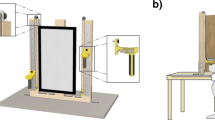Summary
The acquisition of co-ordination between posture and movement was investigated in human subjects performing a load lifting task.
Sitting subjects held their left (postural) forearm in a horizontal position while supporting a 1 kg load via an electromagnet. Perturbation of the postural forearm position consisted of the load release triggered either by the experimenter (control) or by the subject voluntarily moving the other arm. In the latter case, the movement involved the elbow joint (load lifting (A), isometric force change at the wrist level (B), elbow rotation (C) and pressing a button with the wrist (D)) or the fingers (grip isometric force change). We recorded the maximal amplitude and maximal velocity of the rotation of the postural forearm, the EMG of the forearm flexors on both sides and the force exerted either by the load on the postural arm or by the isometric contraction of the moving arm. The maximal forearm angular velocity after unloading was known to be related to the level of muscle contraction before unloading.
-
1.
In the control situation, repetition of the imposed unloading test resulted in a progressive reduction in the maximal forearm rotation without any decrease in the maximal velocity. The amplitude and duration of the unloading reflex were found to increase in parallel. These results suggest that an adaptive mechanism took place which increased the gain of the unloading reflex loop and reduced the mechanical effect of the perturbation. This mechanism was found to come into play not only in the control situation but also in other paradigms where the perturbation was expected by the subjects.
-
2.
A decrease in both maximal amplitude and velocity of forearm rotation together with a weak “anticipatory” deactivation of the forearm postural flexors was observed when the unloading was caused by an elbow movement (situations A, B, C) which indicates that a feedforward postural control took place. An interlimb coordination was built up and stabilized after 40–60 trials. Pressing a button with the wrist (weak force and displacement) was a less effective means of inducing an anticipatory control of the flexors of the postural forearm, which indicates that the intensity of the central control plays a role in the building up of the coordination.
-
3.
A distal grip action exerting either weak (100 g) or a high (1 kg) force was able to reduce the maximal amplitude of the forearm rotation, but not the maximal velocity, which indicates that an improved reflex action takes place, but not a feedforward anticipatory postural control.
-
4.
It is concluded that both feedback and feedforward phasic postural controls play a role in the stabilization of the forearm position when a postural perturbation is caused by a voluntary movement. The acquisition of the feedforward postural control depends on the central command per se rather than on the resulting movement parameters. In addition, proximal joints are more appropriate for building up the coordination than the finger joints.
Similar content being viewed by others
References
Angel RW, Eppler W, Iannone A (1965) Silent period produced by unloading of muscle during voluntary contraction. J Physiol (Lond) 180:864–870
Dietz V, Quintern J, Berger W (1985) Afferent control of human stance and gait: evidence for blocking of group I afferents during gait. Exp Brain Res 61:153–163
Dufossé M, Hugon M, Massion J (1985) Postural forearm changes induced by predictable in time or voluntary triggered unloading in man. Exp Brain Res 60:330–334
Dufossé M, Hugon M, Massion J, Paulignan Y (1987) Bimanual load-lifting task: a model for the study of coordination between posture and movement. In: Struppler A, Weindl A (eds) Clinical aspects of sensory motor integration. Springer, Berlin Heidelberg, pp 298–304
Gahery Y, Massion J (1981) Coordination between posture and movement. Tins 4:159–202
Forget R, Lamarre Y (1986) Central control of anticipatory postural adjustment asociated with active unloading. Neurosci Lett Suppl 26:S275
Hugon M, Massion J, Wiesendanger M (1982) Anticipatory postural changes induced by active unloading and comparison with passive unloading in man. Pflügers Arch 393:292–296
Konorski J (1967) Integrative activity of the brain: an interdisciplinary approach. The University of Chicago Press, Chicago
Lacquaniti F, Maioli C (1987) Anticipatory and reflex coactivation of antagonist muscles in catching. Brain Res 406:373–378
Lacquaniti F, Maioli C (1989) The role of preparation in tuning anticipatory and reflex responses during catching. J Neurosci (in press)
Massion J, Viallet F, Massarino R, Khalil R (1989) Supplementary motor area region is involved in the coordination between movement and posture. CR Acad Sci (Paris) 308:417–423
Struppler A, Burg D, Erbel F (1973) The unloading reflex under normal and pathological conditions in man. In: Desmedt JE (ed) New developments in electromyography and clinical neurophysiology, Vol 3. Karger, Basel, pp 603–617
Author information
Authors and Affiliations
Rights and permissions
About this article
Cite this article
Paulignan, Y., Dufossé, M., Hugon, M. et al. Acquisition of co-ordination between posture and movement in a bimanual task. Exp Brain Res 77, 337–348 (1989). https://doi.org/10.1007/BF00274991
Received:
Accepted:
Issue Date:
DOI: https://doi.org/10.1007/BF00274991




